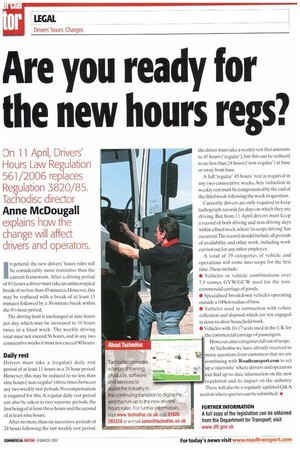Are you ready for the new hours regs?
Page 40

If you've noticed an error in this article please click here to report it so we can fix it.
On 11 April, Drivers' Hours Law Regulation 561/2006 replaces Regulation 3820/85.
Tachodisc director Anne McDougall explains how the change will affect drivers and operators.
In general, the new drivers' hours rules will be considerably more restrictive than the current framework. After a driving period of 41/2 hours a driver must take an uninterrupted break of no less than 45 minutes. However, this may be replaced with a break of at least 15 minutes followed by a 30-minute break within the 41/2-hour period.
The driving limit is unchanged at nine hours per day, which may be increased to 10 hours twice in a fixed week. The weekly driving total must not exceed 56 hours, and in any two consecutive weeks it must not exceed 90 hours.
Daily rest
Drivers must take a (regular) daily rest period of at least 11 hours in a 24 hour period. However, this may be reduced to no less than nine hours ('non-regular') three times between any two weekly rest periods. No compensation is required for this. A regular daily rest period can also be taken in two separate periods, the first being of at least three hours and the second of at least nine hours.
After no more than six successive periods of 24 hours following the last weekly rest period, the driver must take a weekly rest that amounts to 45 hours ('regular'), but this can be reduced to no less than 24 hours (non-regular') at base or away from base.
A full 'regular' 45 hours' rest is required in any two consecutive weeks. Any reduction in weekly rest must be compensated by the end of the third week following the week in question.
Currently drivers are only required to keep tachograph records for days on which they are driving. But from 11 April drivers must keep a record of both driving and non-driving days within a fixed week, where 'in-scope driving' has occurred.The record should include all periods of availability and other work, including work carried out for any other employer.
A total of 29 categories of vehicle and operations will come into scope for the first time:These include: • Vehicles or vehicle combinations over 7.5 tonnes GVW/GCW used for the noncommercial carriage of goods.
• Specialised breakdown vehicles operating outside a 100km radius of base.
• Vehicles used in connection with refuse collection and disposal which are not engaged in door-to-door household work.
• Vehicles with 10-17 seats used in the UK for the commercial carriage of passengers. However, nine categories fall out of scope. At Tachodisc we have already received so many questions from customers that we are combining with Roadtransport.com to set up a `microsite' where drivers and operators can find up-to-date information on the new regulation and its impact on the industry. There will also be a regularly updated Q&A section where queries can be submitted.
FURTHER INFORMATION
A lull copy ol the legislation can be obtained from the Department for Transport; visit www.dft.goy.uk






















































































































































































